Leaderboard
Popular Content
Showing content with the highest reputation on 08/07/23 in Posts
-
I'm sorry to have kept you in agony for this long which must have given you many sleepless nights, but finally, to my great joy, I have identified and fixed the source of the low amplitude issue, resulting in excellent improvements. Upon close inspection (40X magnification) I found some very slight rust and oxidation on several of the train wheel pivots. Don't know how I missed that when I serviced the movement the first time around (really a bit embarrassing). Perhaps I simply wasn't looking close and/or long enough, and no, the rust didn't get there after the service as I wasn't wearing it due to its poor timekeeping. So, my beloved Steiner Jacot tool to the rescue and what do you know, amplitude in the horizontal positions is now slightly above 300 degrees and around 275 degrees in the vertical positions. I'll never get rid of my Jacot tool for as long as I'm able to breathe and am capable to use it! I haven't had the time to fully assemble the movement yet, but for anyone interested, I get back with the measured amplitude after 24 hours of fully wound.3 points
-
I can't find any info on this movement. Who is the manufacturer? And as others have commented: pictures, please! I'm going to assume "easily" means the balance has a movable hairspring stud, yes? You didn't have to rotate the hairspring collet on the balance staff? For me, this would suggest the timegrapher is confused by the sounds it's hearing and not giving you correct information. Here are the questions I'm asking myself if I'm the one troubleshooting this: Did you take an initial timegrapher reading, and was it giving a reasonable number for gain/loss per day? What kind of timegrapher are you using? What does the timegrapher readout look like? Straight lines? Snow globe? Wavy gravy? After that, I'd be looking at anything that could be causing noise that would confuse the timegrapher. Things like the hairspring rubbing on the balance cock or wheel. The balance wheel wobbling and contacting one of the train wheels. Overbanking. Etc. There's a great document that gets shared around for interpreting the results. Let me see if I can find it... Witschi Training Course.pdf2 points
-
Yes. It's too easy to round off the edges. Especially when using a small diameter rotary tool, like a Dremel. I think one of the better case finishing videos is by the Nekkid Watchmaker. To keep the sharp edges, he uses a lapping machine. Another interesting polishing machine is the Jool Tool. There are some videos on YouTube showing its use.2 points
-
Usually problems with the hairspring result in low amplitude and faster rates. You say that adjusting the regulator doesn't change anything, which leads me to suspect that the hairspring has slipped out of the regulator. Check if this is the reason. And John says, we relish photos.2 points
-
Hello and welcome. I wish you had asked for advice before starting, the movement wanted removing from the case before removing the plate. I can't see the click, it should be visible once the movement is removed. If you open the other side of the case, the movement should come out. Send more pictures then. You have chosen a difficult movement to start on as it is a full plate.2 points
-
What ! £800 is this now or sometime next century ? A 4 an half inch grinder with a good diamond concrete scrubbing wheel will do the job just fine.......... i jest please dont try that at home boys and girls I would say generally yes . Have you not watched any of Joe's YouTube videos ?1 point
-
Thank you all for the warm welcomes! Sadly no tractor here! Though I am sure that would be an even bigger headache to work on than most watches. What I was using it for was to remove the crimp for the bracelet clasp on a woman's watch. The crimp is pretty small but the metal was tough enough that I couldn't bend it by just pressing hard enough with a small punch. It got me annoyed so some light taps with the hammer did the trick. I wish it had a more practical and useful purpose like the one @Nucejoe suggested, but the answer is a little less exciting. In my sophomore year at college I had a manufacturing and design course (as a part of the mechanical engineering curriculum) where we learned, as some might guess, manufacturing and design. While learning about the theory and limitations of design and machining, we had to design that piece you see there. All it is is a gearbox with 2 gears, but each component was supposed to give us some exposure to different modes of manufacturing and material types.1 point
-
I've had this problem - ran the balance through the U/S cleaner 2x with Elma cleaner/rinse/IPA, and still sticking together. I did try acetone, and it solved it for me. From what I've read, it doesn't dissolve shellac1 point
-
Some of those Jool Tool discs look scarily aggressive. But the open design of them lets the user see everything thats happening with the polishing process.1 point
-
I've found one of the most difficult thing to do when polishing a case is maintaining it's original edges. Very easy to take a sharp edge away. You see a lot of overpolished cases on ebay that look too smoothed out.1 point
-
Hi as Richard said ask for advise first,,!. You will hopfully be lucky that the movement was in a rundown state before you removed the plate as that’s where the click usually is. My advise is to refit the plate carefully not breaking the pivots and then remove the movement complete from the case. The clock on yours might be on the front plate but turning the movement out will displace the barrel if you don’t have the plate ON. Once you have the plate on and the movement out of the case you can start, let down the power ( if any left) remove the balance after checking that is spins in both directions with a puff of air. Removing plates as you have done could suddenly release the mainspring resulting in major damage, teeth off the wheels, broken pivots, the spring it’s self breaking, so if not sure please ask.1 point
-
Seiko 2119-0090 P June 1969 Replacement crystal, Setting lever spring. Loose cannon pinion and sticking hairspring. All fixed and running properly again + 2 SPD on wrist. My uncles watch since early 70s. He gave a stranger a lift home from the pub. The guy left his coat in my uncles car and was never to be seen again to this day. The watch was found in the coat pocket. No way of contacting people in those days like there is today to be able to hand it back.1 point
-
I found a set of vintage favorite punches to replace the two damaged ones in the staking set, i asked dimensions this time before i got them to make sure they were 4mm, there are some extra punches that i didn't have and a few spares if i ever need replacements. The shanks on the bergeon anvils seem to be 4.7mm from bergeons website data sheet, i don't know how easy it would be to turn down the shank to 4mm on a lathe as they are hardened steel, maybe easier to make 7 new stumps, i've got my eyes peeled for a lathe, one tool seems to lead to another.1 point
-
For future reference, on a cylinder escapement it's imperative to let all power off before removing the balance.1 point
-
I've just got my first staking set made by favorite, it's a vintage set so don't know how old it is, the anvil body is silver/chrome and as the detatchable base, the anvil is in good condition, the punches and stumps need a clean not rusty more of a dirty tarnish, i've tested that the punches line up with holes in the table below and seems ok, i'm well chuffed it's in such good condition. It has 7 missing stumps out of 16 and 2 damaged punches out of 77, i knew the stumps were missing from the photos and expected a few of the punches maybe damaged from use over the years, i thought i'd just get replacement bergeon ones. I didn't ask if it was a 4.7mm set i wrongly assumed it was due to it been swiss made, the punches are 4mm diameter not 4.7mm so not abe to use the bergeon ones from cousins. Can i still use the bergeon stumps, what size are the bergeon stumps that fit into the table are they 4.7mm or 4mm? Are 4mm stumps available, i've had a look on a few sites but cannot find anything, i still think i got a good staking set it seems to be a quality tool although alot smaller than i expected, photos of watch tools seem to make them look alot bigger.1 point
-
I do remember somebody saying once about how pallet forks should move effortlessly exactly as you're trying to test for. But I've also seen examples of poised pallet forks. then pictures I had to go to the Internet to find a picture of your pallet fork. The arm not sure what part it's called that goes towards the balance wheel doesn't look very long. Also it's a really tiny pallet fork it may just not have enough mass to move whether it's poised are not. so basically what you're telling us is were searching for the original problem that was never found. Always nice when looking for a problem to understand what it is were looking for. this is why typically ask people who just service the watch that's not running I ask the question what was it doing before. It helps isolate whether the problem was caused by servicing or not. with the pallet fork out if you slowly started to wind the watch as the gear train start to spin effortlessly? then when you stop turning do you get back spin?1 point
-
I don't know anything about their ammonia-based cleaner as to how much it smells. I do know their people super sensitive. Then of course they make modern extremely expensive cleaning machines where this is not an issue as you can have activated carbon to filter out that. You can run these machines in a store for instance and nobody has any idea what you're running in the machine. But that excludes us. I just don't remember the ammonia-based cleaners for watches at least as being an issue. Because typically it there in sealed containers except when I was cleaning and I cleaned in another room of the house so I just don't remember it being an issue. But I do know people have complained about the smell of the ammonia that others have complained about basically the solvents they can smell those also. Then definitely experiments we all need experiments I like when people do experiments just don't do it on anything good. Then ammonia in water is common in clock solutions. Now this is where I will complain about the ammonia I have a gallon of the l&r clock solution I believe he makes it one part eight and at least initially I made a whole bunch of mistakes with it. First never open it up in a confined space make sure outside with a breeze ideally should wear a respirator because it's a concentrated solution and yes that I remember how bad it smells. Then using tap water was a very bad idea. Oh with the bonus of I used hot tap water. The problem with water out of your tap is whatever chemical properties that could range from extremely alkaline to I have no idea what but usually it has added bonus of oxygen mixed in. Even though I mixed it at the proper concentration the elevated temperature frosted all the brass clock plates which required polishing. The super clean because the ammonia-based clock cleaner can do a beautiful job of cleaning off every trace of oil that's a problem for iron components. In that there now in a hot solution with oxygen mixed into the water and what exactly is rust made out of anyway? Never mind I would he know the answer to that question. Oh the other thing to try is the one Tarnish removing solutions for silver stuff and jewelry. I forgot about that I used use that for silver things before I discovered the ionic cleaner at work. They just have these one dip solutions read just dip something in and that used to do a really nice job. Often times stuff like that's even available in your local grocery store at least that's the fuzzy memory of where he might've purchased mine. But that was such a long time ago so that is another option even if you didn't dip into the solution you can put it on a cotton swab and rub it on the tarnished parts. Just make sure you clean it off afterwards. So experimentation is in your destiny let us know the results.1 point
-
For this kind of tarnish on nickel plated and gold plated movement (or any kind), I learned long ago to use blanc d'Espagne, also known as blanc de Moudon, or in English sometimes White of Spain, or just whiting powder. It's super finely ground calcium carbonate, and is used for all kinds of stuff like making gesso, or whitewashing windows and so forth- and is the main ingredient in most chalk*. Available here from drugstores/ art supply/ hardware stores. Should be fairly easy to find about anywhere. To clean up plates and bridges, take a pinch and rub it wet (with water) all over the stained area. It won't leave scratches or mess up the original finish, but does a great job of getting those stains off. *French chalk is magnesium silicate. Very old watchmaking books mention it often, and many old benches had a cubby hole right in the front for a block of chalk, which you were to rub a long bristle brush over, then brush down the plates and bridges. I think the idea was to brighten things up. So, while I haven't tried it, you might try French chalk as well. It's what talcum powder is made from, so that's an easy source of powder form.1 point
-
I noticing you using a cleaning product without ammonia. Ammonia is an interesting substance and watch cleaning. A short time in the ultrasonic with ammonia and everything comes out bright and shiny. It's the ammonia that removes the tarnish so if you had a ammonia-based cleaner that would probably be bright and shiny. But if left too long in the cleaner with ammonia it goes from bright and shiny to etching basically. This solution will turn a pretty blue color and the copper in the brass will be gone and things will be frosty. then as you leave it a very long time basically an unacceptably long time and then you'll start to see some really bad effects apparently. No matter what that's an interesting work on your plates. then a pinky eraser is actually a abrasive device not as abrasive as sandpaper but still it's abrasive. That's why you're finding a clean but not bright and shiny because of its abrasive properties. then there's an alternative. I would have posted this sooner but I couldn't quite remember what it was called and trying to figure out by searching alternative names reveals well doesn't reveal this. So you looking for an ionic cleaner this seems be the most common one I see there's other videos on YouTube but you can get the idea from this video. so basing that just works really nice on tarnish. Here watch plates or somebody once their case to look nice but doesn't want a polished it works fine.1 point
-
Dear all, I recently got hooked on early quartz watches. Now I bought a package with untested Timex quartz and electric watches, among them the watch shown below, the rare M62. It does not run and the crown does not pull out - which is the main problem for now. I do now how to remove the stem on Timex M40 family watches, but this one is different. Does anyone have advice? Many thanks for your time! Chris1 point
-
DOCK - yes, these early Timex quartz are extremely accurate. The original selling price for them in 1972 was $125.00 which was well above the average for other Timex watches. What you want to be careful with when taking out the electronic bits is to keep note of which screws fit to each location because the length of them varies. One tip I can give you is that when you refit the new stem is to add a little grease to the tip. This improves the rotation while setting the time. Here is my collection of the watch along with one I used for parts. Notice the one I am missing to complete the set is the one you have. I do have NOS crown stems for them and can list under by eBay id of pack43.1 point
-
Okay, so this is very strange. I pulled the hands, and then reset them all. When I was done, the hour and minute hand were both over each other on the 12. I advanced the time through 12 hours, and now the hour is on the 12, but the minute hand is faster by 18 minutes. I'm not sure what to look at at this point.0 points





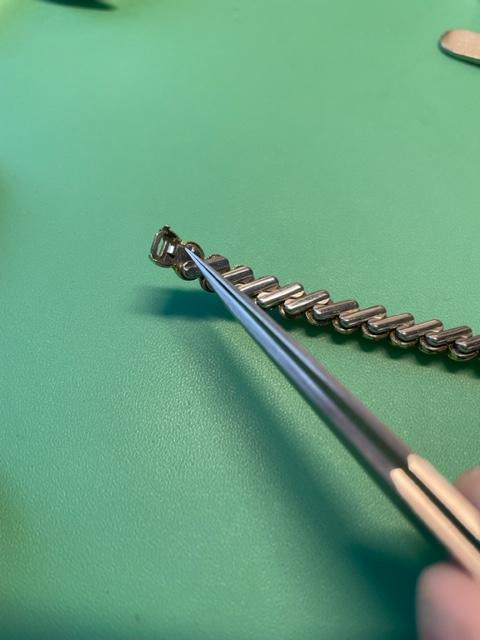

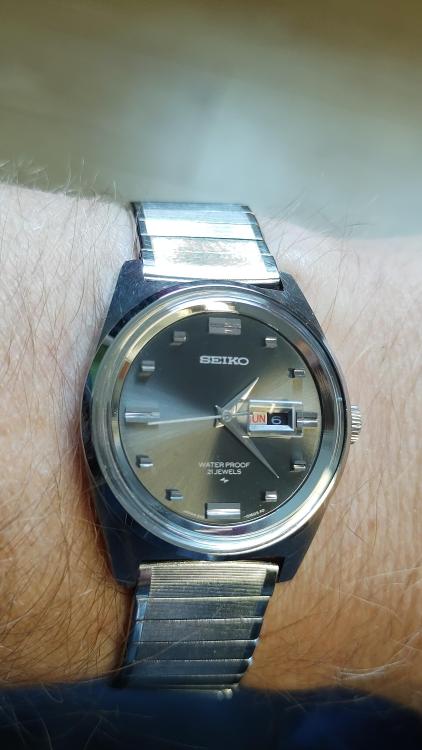
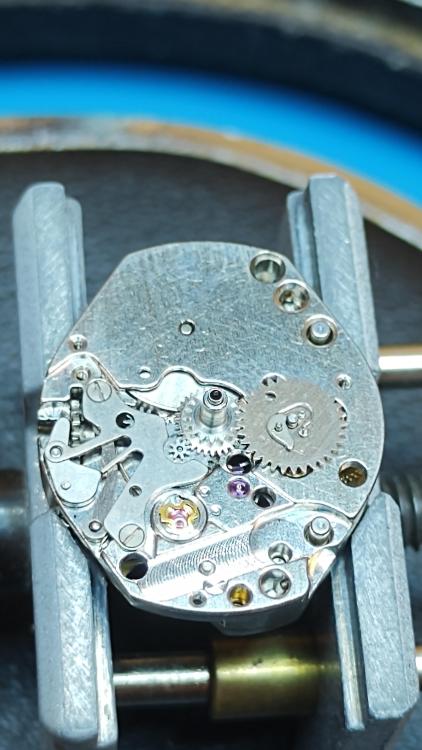
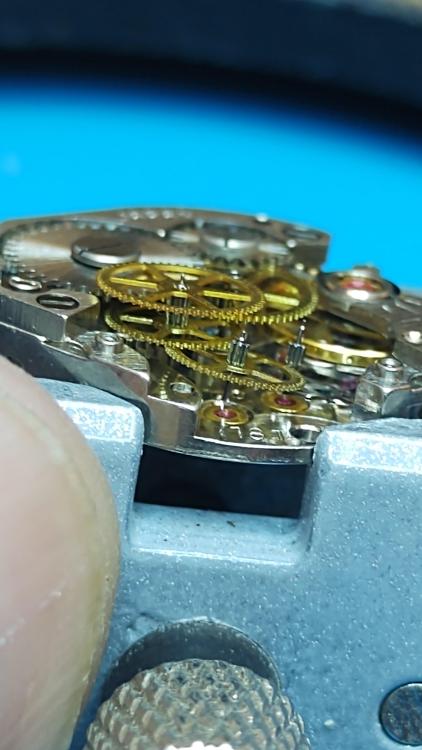

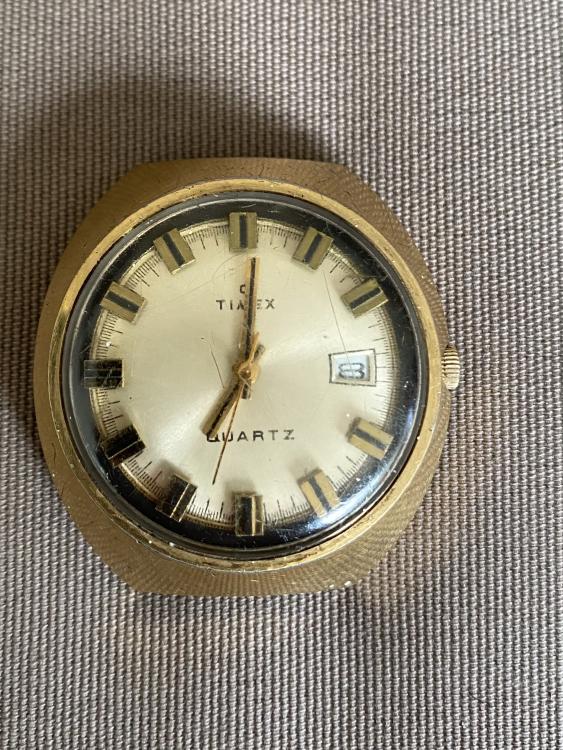
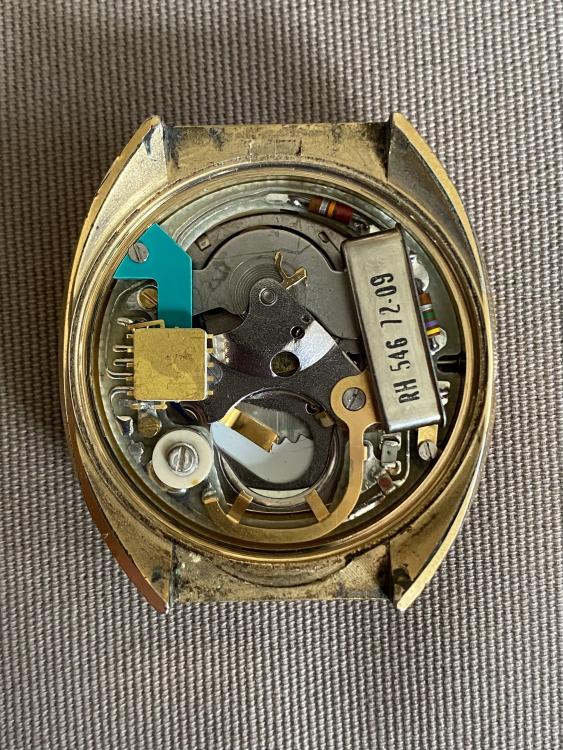

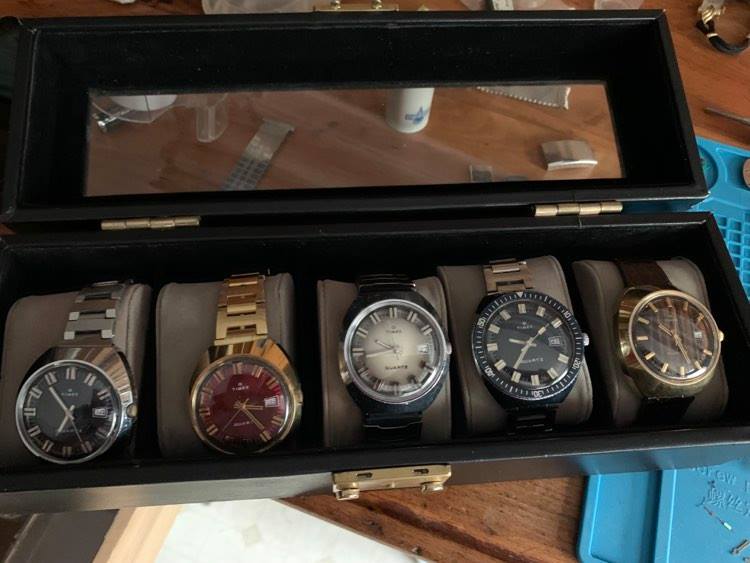
.thumb.jpg.5cefae4acfc8881fdf3389b0679fe532.jpg)
